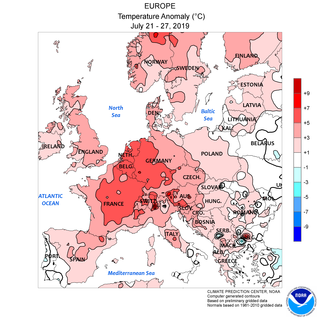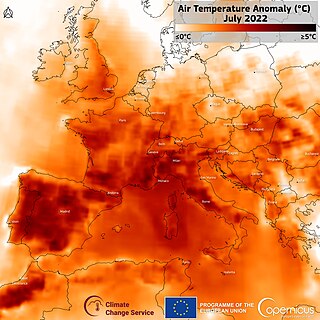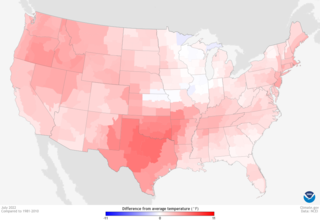
A heat wave, sometimes described as extreme heat, is a period of abnormally hot weather. Definitions vary but are similar. A heat wave is usually measured relative to the usual climate in the area and to normal temperatures for the season. Temperatures that humans from a hotter climate consider normal, can be regarded as a heat wave in a cooler area. This would be the case if the warm temperatures are outside the normal climate pattern for that area. High humidity often occurs during heat waves as well. This is especially the case in oceanic climate countries. Heat waves have become more frequent, and more intense over land, across almost every area on Earth since the 1950s. Heat waves occur from climate change.

The 2010 Northern Hemisphere summer heat waves included severe heat waves that impacted most of the United States, Kazakhstan, Mongolia, China, Hong Kong, North Africa and the European continent as a whole, along with parts of Canada, Russia, Indochina, South Korea and Japan during July 29 2010. The first phase of the global heatwaves was caused by a moderate El Niño event, which lasted from June 2009 to May 2010. This lasted only from April 2010 to June 2010 and caused only moderate above-average temperatures in the affected regions, but it also set new record high temperatures for most of the area affected in the Northern Hemisphere.
The 2013 heatwave in the United Kingdom and Ireland was a period of unusually hot weather primarily in July 2013, with isolated warm days in June and August. A prolonged high pressure system over Britain and Ireland caused higher than average temperatures for 19 consecutive days in July, reaching 33.5 °C (92.3 °F) at Heathrow and Northolt.

The 2018 Britain and Ireland heatwave was a period of unusually hot weather that took place in June, July and August. It caused widespread drought, hosepipe bans, crop failures, and a number of wildfires. These wildfires worst affected northern moorland areas around the Greater Manchester region, the largest was at Saddleworth Moor and another was at Winter Hill, together these burned over 14 square miles (36 km2) of land over a period of nearly a month.
The 2018 North American heat wave affected regions of Canada, where at least 70 deaths in Quebec were heat-related, the United States, where 18 states between Michigan and New Mexico issued heat advisories to a population of over 60 million people, and of Mexico, particularly the northwest and central regions.
Throughout much of July 2018, a record-breaking heat wave affected large areas of Northeast Asia including Japan, North Korea, South Korea and China. Many areas in Japan experienced temperatures in excess of 35 °C (95 °F), and Kumagaya recorded a maximum temperature of 40.8 °C (105.4 °F) on 23 July – the highest ever observed in the country.

The 2018 European drought and heat wave was a period of unusually hot weather that led to record-breaking temperatures and wildfires in many parts of Europe during the spring and summer of 2018. It is part of a larger heat wave affecting the northern hemisphere, caused in part by the jet stream being weaker than usual, allowing hot high-pressure air to linger in the same place. According to the European Drought Observatory, most of the areas affected by drought are across northern and central Europe. According to the World Meteorological Organization, the severe heat waves across the northern hemisphere in the summer of 2018, are linked to climate change in Europe, as well as events of extreme precipitation.

In late June and late July 2019 there were two temporally distinct European heat waves, which set all-time high temperature records in Belgium, France, Germany, Luxembourg, the Netherlands, and the United Kingdom.

The 2021 Western North America heat wave was an extreme heat wave that affected much of Western North America from late June through mid-July 2021. The heat wave affected Northern California, Idaho, Western Nevada, Oregon, and Washington in the United States, as well as British Columbia, and in its latter phase, Alberta, Manitoba, the Northwest Territories, Saskatchewan, and Yukon, all in Canada. It also affected inland regions of Central and Southern California, Nevada, and Montana, though the temperature anomalies were not as extreme as in the regions farther north.
The 2021 Britain and Ireland heat wave was a period of unusually hot weather in July 2021 that led to record-breaking temperatures in the UK and Ireland.

In 2022, several areas of the world experienced heat waves. Heat waves were especially notable in East Asia, the Indian subcontinent, Australia, western Europe, the United States, and southern South America. 2022 heat waves accounted for record-breaking temperatures and, in some regions, heat-related deaths. Heat waves were worsened by the effects of climate change, and they exacerbated droughts and wildfires.

The 2022 India–Pakistan heat wave was an extreme weather event which resulted in the hottest March in the subcontinent since 1901. The hot season arrived unusually early in the year and extended into April, affecting a large part of India's northwest and Pakistan. The heatwave was combined with a drought, with rainfall being only a quarter to a third of normal. It occurred during a La Niña event, in which heat records are generally less likely.

The 2022 Japan heatwave was a heatwave that affected many prefectures. Temperatures peaked at 40.2 °C (104.4 °F) in Isesaki, Gunma Prefecture. 15,657 people were taken to hospital emergency departments, 5,261 of whom were admitted.

The 2022 United Kingdom heatwaves were part of several heatwaves across Europe and North Africa. The United Kingdom experienced three heatwaves; the first was for three days in June, the second for three days in July, and the third for six days in August. These were periods of unusually hot weather caused by rising high pressure up from the European continent. There were also more grass fires and wildfires than average, and in August a drought was declared in many regions.

From June to August 2022, persistent heatwaves affected parts of Europe, causing evacuations and killing tens of thousands. These heat waves were the deadliest meteorological events in 2022. The highest temperature recorded was 47.0 °C (116.6 °F) in Pinhão, Portugal, on 14 July.

From late spring to late summer heat waves in 2022 smashed many records in North America between May and September of that year. Dozens of temperature records were surpassed in the United States.

From June to 31 August 2022, China had a severe heat wave which affected several provinces and municipalities. To date, it is the country's worst heat wave to have existed. According to weather historian Maximiliano Herrera, it is the most severe heat wave recorded anywhere in the world.

A number of heat waves began across parts of the northern hemisphere in April 2023, many of which are ongoing. Various heat records have been broken, with July being the hottest month ever recorded.

In 2023, Europe has been affected by heat waves. The most significant of these so far has been the named heat wave, Cerberus Heatwave, which is expected to bring the hottest temperatures ever recorded in Europe. Starting on 10 July 2023, the record-breaking Cerberus anticyclone affected many European countries, with the effects felt most severely in parts of Southeast and Southwest Europe such as Cyprus, Greece, Italy, and Spain. The private Italian weather website iLMeteo named the extreme weather event after the hound of Hades from Greek mythology, and although some reports link the naming to the Italian Meteorological Society, the society's president said that they "absolutely don’t use it".

















